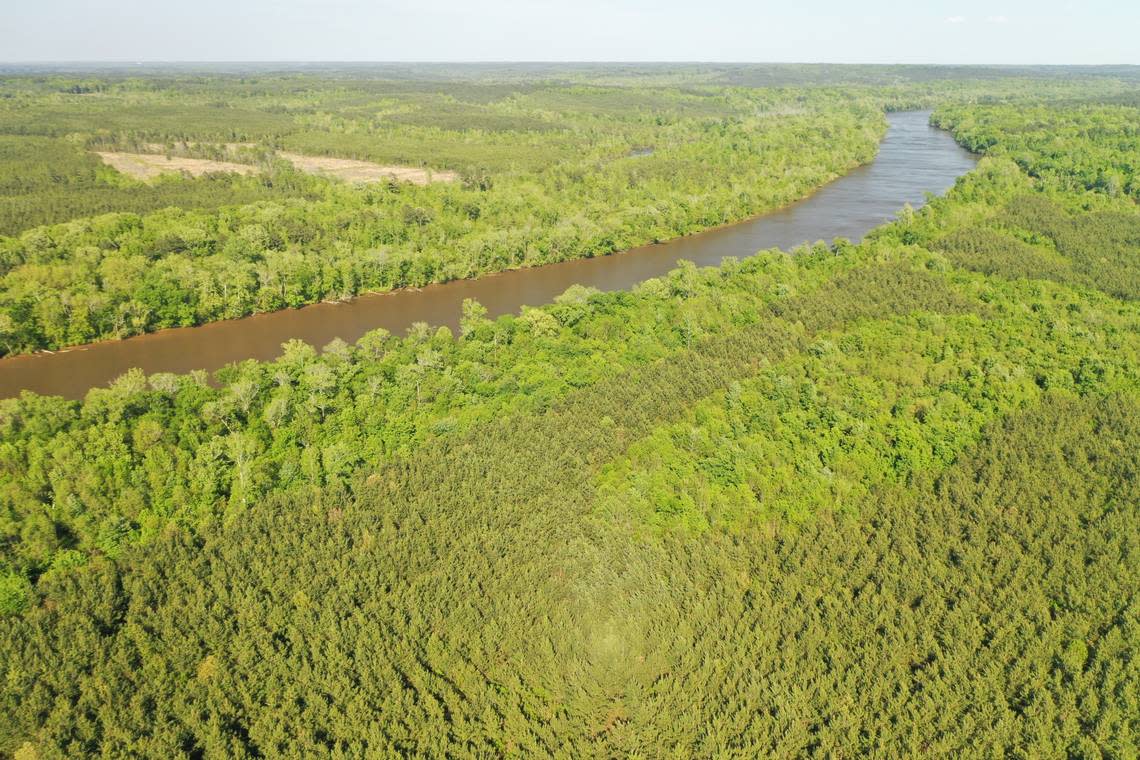Analysis: Millions of acres of NC wetlands can be developed due to SCOTUS, NC law
When North Carollna lawmakers passed a provision in last year’s Farm Act that prevented development only in wetlands protected by the federal government, they couldn’t answer a key question: How many acres of wetlands here would lose protection?
A new Environmental Defense Fund analysis uses a U.S. Fish and Wildlife’s National Wetlands Inventory and flooding data to try to answer that question for all 50 states in light of the U.S. Supreme Court’s rollback last year of which wetlands are protected under the Clean Water Act.
For North Carolina, the answers range from bad to worse, with the analysis determining that anywhere between 14% and 100% of the state’s non-coastal wetlands could be open to development. Those wetlands cover 490,000 to 3.6 million acres, many of them in the low-lying coastal plain.
The wide range of risk in the analysis is due to ongoing litigation about what constitutes a federally protected wetland, said Adam Gold, the report’s author and an EDF manager for climate resilient coasts and wetlands in North Carolina and Virginia
“The Supreme Court used really unclear language and this leaves the door wide open for potential interpretations,” Gold told The News & Observer.
What do Farm Act supporters say?
The timing of the North Carolina bill’s passage was just weeks after the U.S. Supreme Court’s 2023 Sackett V. EPA decision, a rollback of federal wetlands protections.
The decision narrowed which wetlands the federal Clean Water Act protects to those continuously “adjoining” streams, oceans, rivers and lakes in the U.S.

The N.C. Home Builders Association was a key force behind last year’s rule change in North Carolina, arguing that the change was introduced to prevent state environmental officials from regulating some isolated wetlands no longer protected by federal rules.
North Carolina has other state and local rules that will protect many wetlands that could lose federal protections, Chris Millis, the Home Builders Association’s director of regulatory affairs, told The News & Observer. He pointed to riparian buffer rules, vegetated areas near streams; watershed protection overlays that limit development and require stormwater controls in areas that are important to drinking water supplies; and floodplain protections that curb development in flood-prone areas.
“When all the dust settles, when we look at our state regulatory framework I think a lot of these claims of millions of acres of wetlands being able to be developed are not going to come true,” Millis said. “Not only are we not interested in developing in wetlands, there’s other regulatory schemes that are already in place to protect any type of hydric areas that might be of concern.”
Millis also pointed to a March 2024memo from Assistant Secretary of the Army Michael Connor to the U.S. Army Corps of Engineers directing the agency to continue including wetlands that are no longer federally protected due to the Court’s decision in Corps mitigation projects. That means that even though a wetland might no longer be federally protected from development, the Corps could restrict development there.
Citing reduced protections for some North Carolina wetlands, Gov. Roy Cooper vetoed the 2023 Farm Act. The Southern Environmental Law Center applauded, saying the act threatened ecologically important wetlands such as mountain bogs, Carolina Bays, swamps and pocosins here. But legislators overrode Cooper’s veto.
The Farm Act provision was necessary, Millis said, due to a 2011 state law that said environmental regulations cannot be stricter than federal rules. As the Trump Administration was leaving office in 2020, it created new rules around what is considered a protected water, and North Carolina’s Department of Environmental Quality responded with a state rulemaking effort that attempted to enshrine what had been protected before the Trump-era changes.
But the Rules Review Commission decided that state rule, which DEQ officials was said was intended to fill a gap created by the misalignment of state and federal policies, went further than the federal policy.
“If anyone believes those are areas of environmental significance that need to be protected, then you’ve got to have permission of the legislature,” Millis said.
Why do wetlands matter?
Wetlands are a key point of regulatory conflict, with businesses and developers arguing that protections are applied too broadly, stymieing building projects that should move forward with ease.
Environmental groups say wetlands are key to a clean environment because they filter pollutants out of water and protect against flooding. An acre of wetlands can hold between a million and 1.5 million gallons of water, according to the EPA.
That’s particularly important in isolated wetlands found in the Piedmont or North Carolina mountains, Gold said. By retaining water, he said, those wetlands reduce the amount of floodwater flowing downstream, helping everyone in the stream or river basin below.
But because they aren’t sitting next to or flowing into a federally protected stream, the Court’s decision and North Carolina’s law leave them open for fill, he said.
“The wetlands that are most at risk after this decision are the ones that are most critical for flood storage because they are towards the headwaters of watersheds,” Gold said.

Appearing on a panel about wetlands at last week’s N.C. Water Resources Research Institute, John Dorney, a former manager for North Carolina’s wetland permitting program, predicted that the new rules will result in a net loss for wetlands in the state, with effects like degraded water quality and increased flooding.
“There’ll be more development in what are scientific wetlands, especially near developing areas: Wilmington, Greenville, New Bern, Brunswick County,” Dorney said.
Potential NC impacts
To better understand the possibilities, Gold ran eight different scenarios, each representing a different potential definition of the continuous-surface connection.
“We’re kind of along for the ride with the Supreme Court on this. So whatever the federal definition ends up being, North Carolina will be adhering to,” Gold said.
Here’s what those scenarios were for wetlands to be federally protected and what they meant for North Carolina:
No wetlands excluded, in which wetlands were not omitted from federal protections for being too dry: Between 8 and 19% of NC wetlands lose protection, ranging from 285,200 to 676,7000 acres.
Wetlands must have seasonally water-logged soils: Between 27 and 37% lose protection, ranging from 983,600 to 1.3 million acres.
The soil in a wetland must always be wet: 63 to 66% lose protection, ranging from 2.3 to 2.4 million acres.
A wetland must be flooded seasonally: 63 to 66% lose protection, ranging from 2.3 to 2.4 million acres.
Wetlands must flood seasonally and always have saturated soils: 87 to 88% lose protection, about 3.2 million acres.
A wetland must almost always have surface water: 88 to 89% lose protection, about 3.2 million acres.
A wetland must always have surface water, except during extreme droughts: 100% lose protection, about 3.6 million acres.
A wetland must always have surface water: 100% lose protection, about 3.6 million acres.
Could new rule lead to pollution?
Another concern environmental lawyers have about the Farm Act is that it goes further to roll back protections than previous rollbacks, which were primarily focused on permitting the filling in of certain wetlands for development activity.
Robin Smith, an environmental lawyer who was previously the assistant secretary for the environment, said the Farm Act’s language also means that other environmental protections no longer apply to wetlands that are now outside of federal jurisdiction.
For example, those wetlands are no longer protected by state rules limiting the discharge of pollutants into water, Smith said in an interview.
“There are just all sorts of ramifications of that that I’m not sure anyone’s really worked through, and I don’t think that was an impact that anyone likely intended or particularly wanted, but it was the result of a very broadly worded piece of legislation,” said Smith, who was was twice chair of this state’s Environmental Management Commission.
Legislative action?
With the new information in hand, environmental advocates hope to start making the case for additional wetlands protections when lawmakers return for the short session next month.
David Kelly, EDF’s North Carolina president, wrote in an email that lawmakers either have to find a way to convince developers to avoid the losses of wetlands or significantly ramp up funding for wetlands conservation and restoration.
“We believe it’s important that science helps inform the policy discussion on wetland conservation in North Carolina and beyond, with the consequences of the Sackett decision providing a clear example of the kind broad ambiguity and uncertainty that can result when policy making is not rooted firmly in science,” Kelly wrote.
The Home Builders Association is willing to entertain further conversations about protecting wetlands, Millis said, as long as the General Assembly gives regulators explicit permission to do so.
“We stand ready; if there are any areas of environmental concern that are affected, we’re open-minded and we’re not trying to develop in areas that are truly wetlands,” Millis said.
NC Reality Check is an N&O series holding those in power accountable and shining a light on public issues that affect the Triangle or North Carolina. Have a suggestion for a future story. Email realitycheck@newsobserver.com.
This story was produced with financial support from the Hartfield Foundation and Green South Foundation, in partnership with Journalism Funding Partners, as part of an independent journalism fellowship program. The N&O maintains full editorial control of the work. If you would like to help support local journalism, please consider signing up for a digital subscription, which you can do here.
